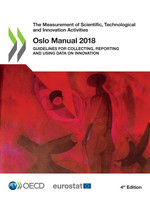This page provides information about OECD work on measuring business innovation survey data and indicators.The OECD has played a key role in the development of international guidelines for surveys of business innovation (Oslo Manual ) and the design of indicators constructed with data from such surveys. In addition to developing methodological guidance, the OECD also carries out analytical studies using innovation-related indicators and microdata. This work is guided by the OECD Working Party of National Experts on Science & Technology Indicators (NESTI).
The OECD Innovation Indicators database is a comprehensive collection of statistics about the innovation activities and outcomes of firms across OECD member countries and other economies. It providing insights into the extent to which companies have incorporated new or improved products (both goods and services) and enhanced business processes.
The November 2023 data release focuses on business innovation activities spanning from 2018 to 2020 across 42 economies including most OECD and EU countries. It provides for the first-time indicators of innovations with environmental benefits and documents the apparent resilience of business innovation at the outset of the COVID-19 crisis.
In addition, as in the previous edition, this round:
Reports indicators based on data collected under the guidelines of the OECD/Eurostat Oslo Manual 2018 .
Incorporates a module of core innovation indicators at the industry level, describing how innovation varies not only across countries but also across industries.
Innovation indicators | Guidelines and definitions | Methodology | Related links
Download the indicators: 2023 (.zip) | 2021 (.zip) | 2019 (.zip) | 2017 (.xls) | 2015 (.xls) | 2013 (.xls)
2023 edition highlights 2021 edition highlights
<a href='#'><img alt='Dashboard 1 ' src='https://public.tableau.com/static/images/In/InnovativeenterprisesthatintroducedinnovationswithenvironmentalbenefitsIWEBwithsignificantcontributionstoenvironmentalprotectionOECDandpartnereconomies2018-2020/Dashboard1/1_rss.png' style='border: none' /></a>
<a href='#'><img alt='Dashboard 1 ' src='https://public.tableau.com/static/images/In/InnovativefirmsandemploymentininnovativefirmsOECDandpartnereconomies2018-2020/Dashboard1/1_rss.png' style='border: none' /></a>
<a href='#'><img alt='Dashboard 1 ' src='https://public.tableau.com/static/images/Fi/FirmsreceivinggovernmentfundingforinnovationincludingRDandexcludingcontractsforgoodsandservicesasapercentageofinnovation-activefirms2018-2020_16999807649230/Dashboard1/1_rss.png' style='border: none' /></a>
The international collection and reporting of business innovation statistics is guided by the recommendations provided in the OECD/Eurostat Oslo Manual. The manual provides common concepts, definitions and classifications for measurement. The 2018 edition of the Oslo Manual identifies two types of innovation for firms:
Product innovation: a new or improved good or service that differs significantly from the firm’s previous goods or services and that has been introduced on the market. This includes significant improvements to one or more characteristics or performance specifications, such as quality, technical specifications, user friendliness, usability, among others.Business process innovation: a new or improved business process for one or more business functions that differs significantly from the firm’s previous business processes and that has been brought into use in the firm. This concerns the different functions of a firm, including production of goods or services, distribution and logistics, marketing and sales, information and communication systems, administration and management, and product and business process development.
Data released in November 2023 is based on the 2018 edition of the Oslo Manual. Previous indicators featured on this page draw on data collected under previous, 2005 guidelines, which among other things treated marketing and organisational forms of innovation separately from product and process innovations.
Results released in November 2023 edition exhibit high degree of international comparability owing for example to an increasing number of countries using standalone innovation surveys as opposed to collecting data on innovation from firms being primarily asked to report their R&D activity. Despite a gradual process of harmonisation based on the Oslo Manual and its periodic updates national innovation surveys still exhibit some significant differences in design and implementation methodology. Results can be influenced by national idiosyncratic choices such as the sequencing and wording of questions, the filtering of firms throughout the questionnaire as well as aspects such as, the choice of the target population, the length of the reference period and data collection and processing methods.
Methodological and analytical work
Indicators collected on an ad-hoc basis from national surveys and the EU Community Innovation Survey:
Other OECD work on innovation:
Coordination with other international work:
 2023 edition highlights (pdf) |
2023 edition highlights (pdf) |  2021 edition highlights (pdf)
2021 edition highlights (pdf)